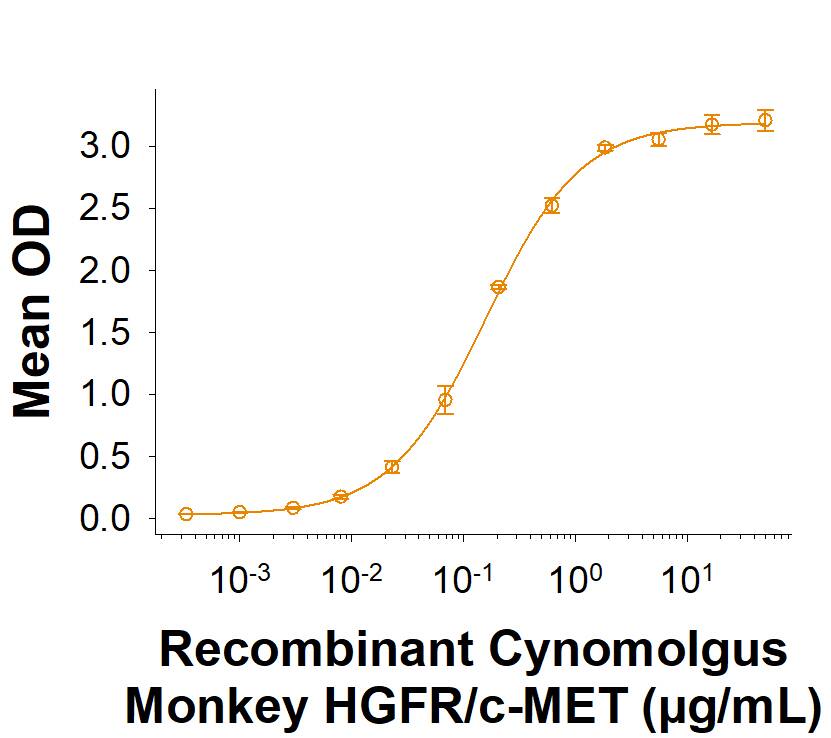Recombinant Cynomolgus HGFR/c-MET His-tag Protein, CF
R&D Systems, part of Bio-Techne | Catalog # 11390-ME

Key Product Details
Product Specifications
Source
Human embryonic kidney cell, HEK293-derived cynomolgus monkey HGFR/c-MET protein
Alpha Chain Glu25-Arg307 & Beta Chain Ser308-Thr932
Alpha Chain Glu25-Arg307 & Beta Chain Ser308-Thr932
Purity
>95%, by SDS-PAGE visualized with Silver Staining and quantitative densitometry by Coomassie® Blue Staining.
Endotoxin Level
<0.10 EU per 1 μg of the protein by the LAL method.
N-terminal Sequence Analysis
Glu25 & Ser308
Predicted Molecular Mass
33 kDa & 70 kDa
SDS-PAGE
41-46 kDa (alpha chain) & 76-84 kDa (beta chain) under reducing conditions.
Activity
Measured by its binding ability in a functional ELISA.
Recombinant Cynomolgus Monkey HGFR/c-MET His-tag (Catalog # 11390-ME) binds to Recombinant Human HGF (NS0-expressed) Protein (Catalog # 294-HGN) with a ED50 of <0.400 μg/mL.
Recombinant Cynomolgus Monkey HGFR/c-MET His-tag (Catalog # 11390-ME) binds to Recombinant Human HGF (NS0-expressed) Protein (Catalog # 294-HGN) with a ED50 of <0.400 μg/mL.
Scientific Data Images for Recombinant Cynomolgus HGFR/c-MET His-tag Protein, CF
Recombinant Cynomolgus Monkey HGFR/c-MET His-tag Protein Binding Activity.
Measured by its binding ability in a functional ELISA. Recombinant Cynomolgus Monkey HGFR/c-MET His-tag Protein (Catalog # 11390-ME) binds to Recombinant Human HGF (NS0-expressed) Protein (294-HGN) with a ED50 of <0.400 μg/mL.Recombinant Cynomolgus Monkey HGFR/c-MET His-tag Protein SDS-PAGE.
2 μg/lane of Recombinant Cynomolgus Monkey HGFR/c-MET His-tag Protein (Catalog # 11390-ME) was resolved with SDS-PAGE under reducing (R) and non-reducing (NR) conditions and visualized by Coomassie® Blue staining, showing bands at 41-46 kDa (alpha chain) & 76-84 kDa (beta chain) under reducing conditions and a single band at 110-130 kDa under non-reducing (NR) conditions.Formulation, Preparation and Storage
11390-ME
| Formulation | Lyophilized from a 0.2 μm filtered solution in PBS with Trehalose. |
| Reconstitution | Reconstitute at 200 μg/mL in PBS. |
| Shipping | The product is shipped with polar packs. Upon receipt, store it immediately at the temperature recommended below. |
| Stability & Storage | Use a manual defrost freezer and avoid repeated freeze-thaw cycles.
|
Background: HGFR/c-MET
References
- Birchmeier, C. et al. (2003) Nat. Rev. Mol. Cell Biol. 4:915.
- Grzelakowska-Sztabert, B. and M. Dudkowska (2011) Growth Factors 29:105.
- Gherardi, E. et al. (2003 ) Proc. Natl. Acad. Sci. 100:12039.
- Park, M. et al. (1987) Proc. Natl. Acad. Sci. 84:6379.
- Crepaldi, T. et al. (1994) J. Biol. Chem. 269:1750.
- Prat, M. et al. (1991) Mol. Cell. Biol. 12:5954.
- Rodrigues, G.A. et al. (1991) Mol. Cell. Biol. 11:2962.
- Kong-Beltran, M. et al. (2004) Cancer Cell 6:75.
- Naldini, L. et al. (1991) Mol. Cell. Biol. 11:1793.
- Ponzetto, C. et al. (1994) Cell 77:261.
- Jeffers, M. et al. (1997) Mol. Cell. Biol. 17:799.
- Orian-Rousseau, V. et al. (2002) Genes Dev. 16:3074.
- Klosek, S.K. et al. (2005) Biochem. Biophys. Res. Commun. 336:408.
- Jo, M. et al. (2000) J. Biol. Chem. 275:8806.
- Wang, X. et al. (2002) Mol. Cell 9:411.
- Trusolino, L. et al. (2001) Cell 107:643.
- Giordano, S. et al. (2002) Nat. Cell Biol. 4:720.
- Conrotto, P. et al. (2004) Oncogene 23:5131.
- Follenzi, A. et al. (2000) Oncogene 19:3041.
- Sonnenberg, E. et al. (1993) J. Cell Biol. 123:223.
Long Name
Hepatocyte Growth Factor Receptor
Alternate Names
c-MET, cMET, HGF R, MET
Gene Symbol
MET
UniProt
Additional HGFR/c-MET Products
Product Documents for Recombinant Cynomolgus HGFR/c-MET His-tag Protein, CF
Product Specific Notices for Recombinant Cynomolgus HGFR/c-MET His-tag Protein, CF
For research use only
